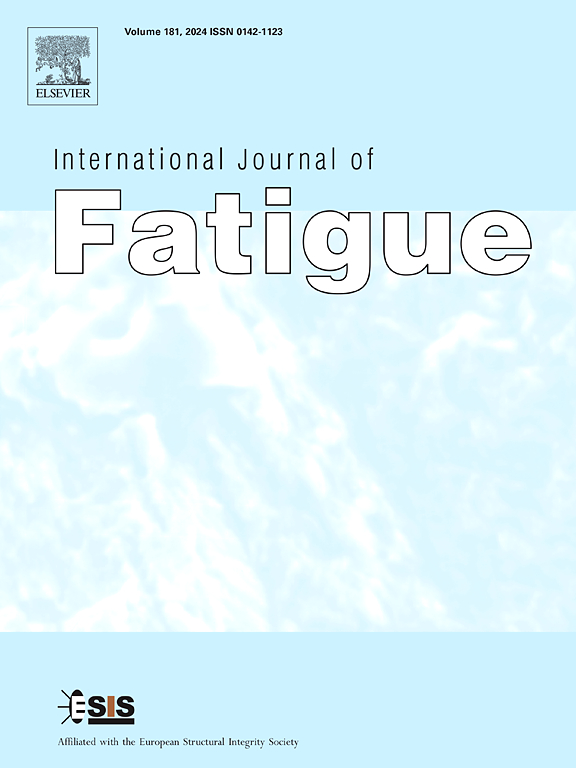Investigating fretting fatigue response of additively manufactured Ti-6Al-4V in dovetail joint connections
IF 5.7
2区 材料科学
Q1 ENGINEERING, MECHANICAL
引用次数: 0
Abstract
Fretting generates surface damage at the contact interface of components under pressure subjected to small-magnitude, relative oscillatory motion. In the presence of bulk cyclic loading, fretting fatigue occurs, significantly reducing the lifetime of affected components, such as the dovetail joint connections in turbine blades. In this research, the fretting fatigue response of additively manufactured (AM) Ti-6Al-4V parts was studied, focusing on the dovetail geometry. A specialized test setup was developed to evaluate the resistance of the AM material to fretting fatigue conditions and compare its response to its conventionally manufactured counterpart. In parallel, a finite element (FE) model of the testing apparatus was created to provide deeper insights into the stress distribution at the contact interface. Results of the numerical simulations revealed that the most damaging mode of fretting fatigue, known as stick–slip, was achieved, closely resembling the conditions often observed in real-life industrial assemblies. The experimental results demonstrate that the tribomechanical fretting fatigue response of AM-Ti64 aligns with that of the conventionally manufactured material. While AM-Ti64 exhibits better crack propagation resistance, it is more prone to fretting damage. However, the AM material is hindered by near-surface internal defects, such as lack-of-fusion-induced voids and porosities, which form during the manufacturing process. These defects act as stress concentrators, leading to early failures outside the contact zone.
增材制造Ti-6Al-4V燕尾接头微动疲劳响应研究
微动在受到小幅度相对振荡运动的压力作用下,在部件接触界面处产生表面损伤。在大量循环载荷存在的情况下,会发生微动疲劳,显著降低受影响部件的寿命,例如涡轮叶片中的燕尾接头连接。本文研究了增材制造Ti-6Al-4V零件的微动疲劳响应,重点研究了零件的燕尾几何形状。开发了专门的测试装置来评估AM材料对微动疲劳条件的抵抗力,并将其响应与传统制造的材料进行比较。同时,建立了测试装置的有限元模型,以更深入地了解接触界面处的应力分布。数值模拟的结果显示,最具破坏性的微动疲劳模式,即粘滑,已经实现,与现实生活中经常观察到的工业组件的情况非常相似。实验结果表明,AM-Ti64的摩擦力学微动疲劳响应与常规制造材料一致。AM-Ti64具有较好的抗裂纹扩展性能,但更容易出现微动损伤。然而,增材制造材料受到近表面内部缺陷的阻碍,例如在制造过程中形成的缺乏熔合诱导的空隙和孔隙。这些缺陷起到应力集中的作用,导致接触区外的早期失效。
本文章由计算机程序翻译,如有差异,请以英文原文为准。
求助全文
约1分钟内获得全文
求助全文
来源期刊

International Journal of Fatigue
工程技术-材料科学:综合
CiteScore
10.70
自引率
21.70%
发文量
619
审稿时长
58 days
期刊介绍:
Typical subjects discussed in International Journal of Fatigue address:
Novel fatigue testing and characterization methods (new kinds of fatigue tests, critical evaluation of existing methods, in situ measurement of fatigue degradation, non-contact field measurements)
Multiaxial fatigue and complex loading effects of materials and structures, exploring state-of-the-art concepts in degradation under cyclic loading
Fatigue in the very high cycle regime, including failure mode transitions from surface to subsurface, effects of surface treatment, processing, and loading conditions
Modeling (including degradation processes and related driving forces, multiscale/multi-resolution methods, computational hierarchical and concurrent methods for coupled component and material responses, novel methods for notch root analysis, fracture mechanics, damage mechanics, crack growth kinetics, life prediction and durability, and prediction of stochastic fatigue behavior reflecting microstructure and service conditions)
Models for early stages of fatigue crack formation and growth that explicitly consider microstructure and relevant materials science aspects
Understanding the influence or manufacturing and processing route on fatigue degradation, and embedding this understanding in more predictive schemes for mitigation and design against fatigue
Prognosis and damage state awareness (including sensors, monitoring, methodology, interactive control, accelerated methods, data interpretation)
Applications of technologies associated with fatigue and their implications for structural integrity and reliability. This includes issues related to design, operation and maintenance, i.e., life cycle engineering
Smart materials and structures that can sense and mitigate fatigue degradation
Fatigue of devices and structures at small scales, including effects of process route and surfaces/interfaces.
 求助内容:
求助内容: 应助结果提醒方式:
应助结果提醒方式:


